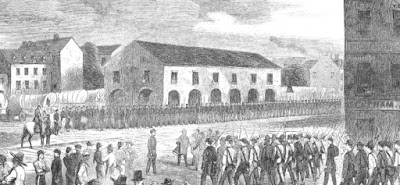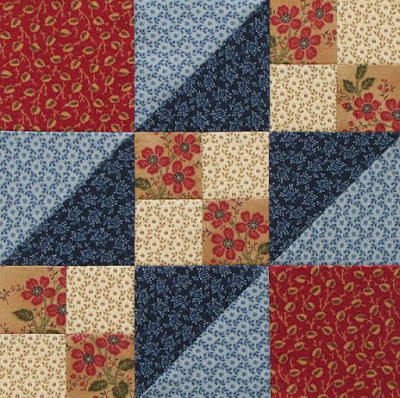This week's post concerns a smaller battle than the other three for which
Winchester, Virginia is known.
Abby Gibbons
Sarah Gibbons Emerson recorded this story about a problem with local Secessionists during the Union Occupation of 1864 in her book about her mother Abby Gibbons. Abby worked with the Sanitary Commission bringing relief supplies to Union troops in Virginia, Winchester residents had stolen some of their supplies.
Market Street in 1861 with Confederate Soldiers marching.
The town was occupied and re-occupied.
"A friend called to say that stores deposited by me at the Relief Rooms in Market Street, had been taken by one Atwell Schell, a member of the church and greatly respected by the Secessionists of the town. We called on the Provost Marshal and stated the facts. He was prompt in giving assistance and allowed us two of his guard, bidding us to use them as we thought best. It was his first day of command."
Abby and her daughter are the seated women here at Fredericksburg
It was not Abby Gibbons's first day of command.
"Accordingly, upon reaching the house of Atwell Schell, and, after being denied a quiet surrender of the stores, I took command and directed one of the guard to remain with my companions below, while I accompanied the other upstairs; the lady of the house being of the party by invitation, to see that we took our own property only.
"While I turned out chests and trunks, and dragged out large bags from under beds and lounges, Atwell Schell put in an appearance, stationed himself against a panel of a door, but not a word did he say. Our goods had been packed with much neatness and care, and covered with their own quilts. Everything was turned out, and package upon package rolled down stairs, until a high stack was formed in the centre of the parlor. There was every variety of garment, bedclothes, delicacies for the sick — such as sugar, tea, chocolate, farina, arrowroot, gelatine, and corn-flour and barley in large packages.
"We found many of our [liquor] bottles (empty, of course, but such as were not to be found in all Winchester). They had been filled with the best stimulants for the sick, but not any of it had been so appropriated — not even to their own Rebel men. No. The citizens of Winchester had stolen it ;
"As I drew out the many heavy packages, the female present — who was either daughter or daughter-in-law of the said Atwell, and, as I afterwards learned, an accomplice in the theft — exclaimed with great vehemence, 'Did you ever hear of such an impudent woman?'Abby replied:
'And what do you have to say of the woman who took these goods and appropriated them to her own purposes? In New York, we should pronounce it theft and punish the transgressor!'
"Enough, perhaps, that we once more possessed our goods. We were not long in making them over to the 32nd Ohio Regiment, whose guard came to the rescue, and whose sick so much needed them.... Prudence admonished us to retreat the next day."I couldn't find an Atwell Schell but perhaps the battle was with the Shell or Shull Family of Winchester.
UPDATE: Suzanne did a little genealogical work and found:
"Atwell Shell appears in the 1860 federal census in Winchester VA born in 1819 in VA, a day laborer by occupation owning real estate valued at $2600 and personal property valued a $300. He is not a man of wealth. He lives with wife Louisa b. 1817, son William H b. 1841 (the perfect age for the Civil War draft), daughter Mary born 1844, son Atwell V born 1849 and son Strawther b. 1856. He does not appear as a slave owner in the slave schedules."
Drawing of Winchester by James E. Taylor
Collection: Western Reserve Historical Society
See more about Abby Gibbons at this post from the past year:
http://civilwarquilts.blogspot.com/2016/10/abigail-hopper-gibbons-civil-war-nurse.html






















































